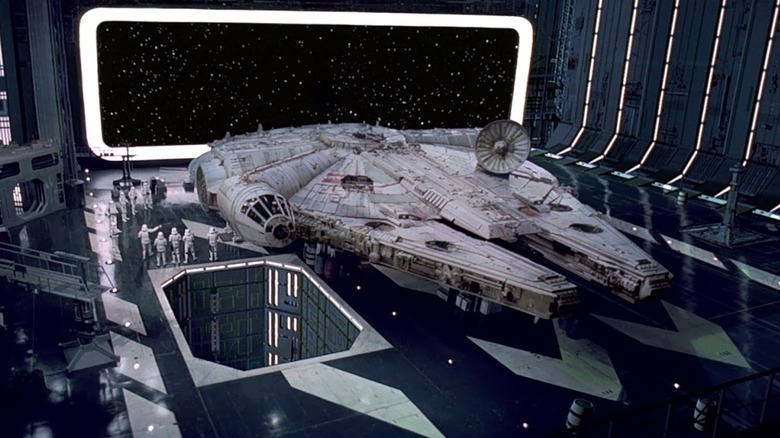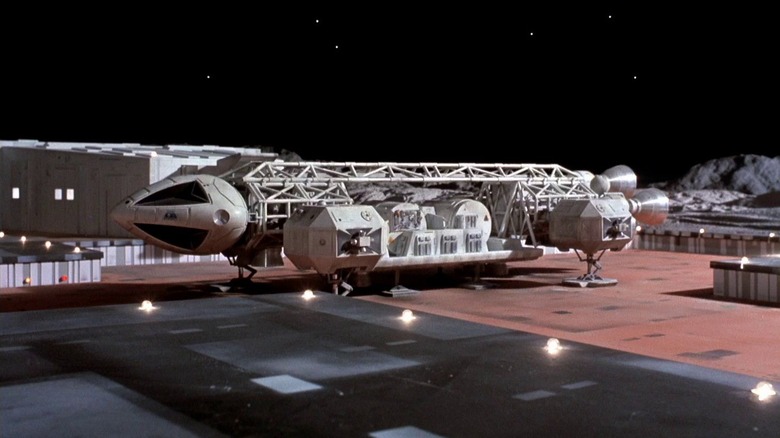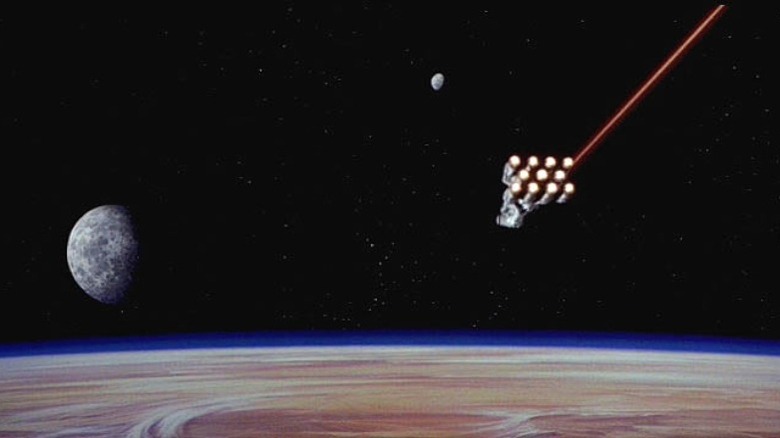A Forgotten Sci-Fi Show Sent Star Wars Scrambling To Redesign The Millennium Falcon
In George Lucas' 1977 sci-fi/fantasy film "Star Wars," the roguish smuggler Han Solo (Harrison Ford) claimed to have the fastest starship in the galaxy. Named the Millennium Falcon, the ship was said to have "made the Kessel Run in less than twelve parsecs." Clearly, Lucas hadn't yet grasped that a parsec is a measure of distance (about 19 trillion miles) and not time.
When it comes to its design, the Millennium Falcon is more or less a flying saucer. It carries a radar dish on its dorsal region, two fork-like protrusions on its bow (called loading arms), and its cockpit rests protruding from its starboard side. Otherwise, it's flat and plate-shaped. Like many of the vehicles in "Star Wars," it is encrusted with textured plating and scads of ineffable machinery that only the most devoted Starwoids could accurately explain. It's a small ship, too, only able to house about a half dozen people comfortably. Luckily, it has a game room. The Millennium Falcom was designed by future blockbuster director Joe Johnston.
The Millennium Falcon has appeared in eight of the 15 "Star Wars" films, as well as innumerable video games. Fans seem to like the little scrapper. It's the sci-fi equivalent of a souped-up 1983 Toyota Corolla. Ugly, but the thing just won't die.
As it so happens, however, Johnston's "flying saucer" design was a last-minute change. According to issue #68 of Star Wars Insider Magazine (the June 2003 issue), the original Millennium Falcon was initially more tube-shaped and sported larger, more visible engines. It just so happened, however, that the original design happened to look almost exactly like the Eagle Transporter, the main ship from the 1975 TV series "Space: 1999."
When they realized the similarities, Lucas and his crew had to scramble to invent a new ship.
The Eagle Transporter vs. the Millennium Falcon
"Space: 1999," for those who are too young to have grown up seeing reruns on network TV, took place in the eponymous year inside Moonbase Alpha, a scientific research facility on the dark side of the moon. In the show's pilot, a massive nuclear explosion knocks the moon out of its orbit, causing it to rocket out into deep space. The moon also passes through a few wormholes, leaving it stranded somewhere in the universe. The denizens of Moonbase Alpha essentially ride the Moon like a massive starship, traveling around the galaxy looking for a new Earth to orbit. "Space: 1999" starred Martin Landau and Barbara Bain as the Moonbase's commander and chief doctor, respectively. The series lasted only two seasons, spanning 48 episodes. It was canceled in November of 1977.
The show's co-creators, Gerry and Sylvia Anderson, were best known for their many TV shows and movies filmed in a process they called Supermarionation, which replaced human actors with marionette puppets. The most famous Anderson Supermarionation shows include "Fireball XL5," "Stingray," "Thunderbirds," and "Captain Scarlet and the Mysterons." When it came to making models and fetishizing starships, few could do it better than Gerry and Sylvia Anderson.
The Eagle Transporter was the most visible ship in "Space: 1999," and, as seen in the photo above, proves to be a definite forebear to the ships in "Star Wars." The Eagle is the Falcon by way of NASA.
According to Star Wars Insider, the original Falcon, designed by Colin Cantwell, looked remarkably like the Eagle, with a similar up-front cockpit, elongated body shape, and eleven engines mounted on the back end. Industrial Light & Magic were given four weeks to redesign the ship.
The Rebel Blockade Runner
Star Wars Insider even said that painter and designer Ralph McQuarrie repainted some of his initial concept art to reflect the updated design of the Millennium Falcon. It went from being a rocket tube to a flying saucer, and the new design was set in stone.
Industrial Light & Magic, however, already had a rocket model they didn't know what to do with, so the original Millennium Falcon was repurposed. Some extra outcroppings and features were attached to the outside, and the ship became a Rebel Blockade Runner, a.k.a. the Tantive IV Alderaan Diplomatic Envoy. It was the ship Princess Leia (Carrie Fisher) was flying in the very first shot of "Star Wars," as she fled the giant wedge-shaped Empire Star Destroyer. A fun mental exercise for Starwoids: can you picture the "Star Wars" movies with the Blockade Runner in place of the Millennium Falcon?
Johnston, meanwhile, would eventually reveal — in the documentary film "Light and Magic" — that his time crunch in designing a new spaceship led him to look around his apartment for hasty inspiration. He saw two dirty dishes in his sink, pressed them together, and his creative gears started turning. The geniuses at ILM slapped together a model and set-builders built out an exterior. For however calculated audiences may assume the outsize "Star Wars" universe to be, know that a lot of the 1977 film's construction was shoddy and quickly assembled.
"Space: 1999," meanwhile, is available to watch on the Shout! Factory TV streaming service, as well as Peacock, Roku, Tubi, Fubo, Crackle, Plex, and Freevee. Because "Star Wars" is only currently available on Disney+, Anderson's show is more widely available. It's also worth your time and attention. The Andersons did good work.


